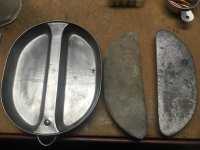Inland7-45
Member
- Joined
- May 16, 2021
- Messages
- 488
- Reaction score
- 651
I am about to start bullet casting again after a long pause. My last run of bullets was made from an alloy of range lead, wheelwrights and type metal. I fellow bullet caster hardness tested some samples and it came close to Lyman # 2 which is what most of my calibers called for.
Since then I have added molds for several additional pistol calibers. I am ready to replace the bullets that I have used up and start casting for the just added calibers.
I still have a few hundred pounds of ingot made from a mix of indoor and outdoor range lead. I continue to have easy access to range lead but the wheel weights and type metal are gone.
When I resume casting I would like to stay as close to the specified bullet material as possible. I want to cast a bullet that will be as accurate as possible while keeping bore leading to a minimum. While at the same time keeping cost down by using as much as possible the free material that I have at hand.
Can anyone offer some advise as to how to alloy this lead to come up with a # 2 alloy? Can I remelt and flux until I have close to pure lead and then add what is needed to the alloy to hit required hardness?
Since then I have added molds for several additional pistol calibers. I am ready to replace the bullets that I have used up and start casting for the just added calibers.
I still have a few hundred pounds of ingot made from a mix of indoor and outdoor range lead. I continue to have easy access to range lead but the wheel weights and type metal are gone.
When I resume casting I would like to stay as close to the specified bullet material as possible. I want to cast a bullet that will be as accurate as possible while keeping bore leading to a minimum. While at the same time keeping cost down by using as much as possible the free material that I have at hand.
Can anyone offer some advise as to how to alloy this lead to come up with a # 2 alloy? Can I remelt and flux until I have close to pure lead and then add what is needed to the alloy to hit required hardness?








